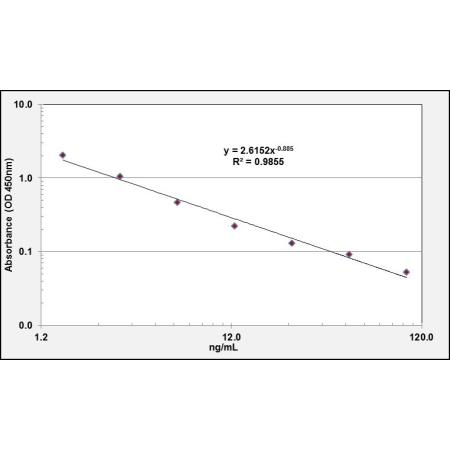Mannose ELISA Kit
Référence OKEH02595
Conditionnement : 96Wells
Marque : Aviva Systems Biology
| Datasheets/Manuals | Printable datasheet for Mannose ELISA Kit (OKEH02595) |
|---|---|
| COA Datasheet | Printable COA datasheet for OKEH02595 |
| Predicted Species Reactivity | All Species | ||||||||||||||||||||||
|---|---|---|---|---|---|---|---|---|---|---|---|---|---|---|---|---|---|---|---|---|---|---|---|
| Application | ELISA-Comp | ||||||||||||||||||||||
| ELISA Kit Detection Method | Colorimetric, OD450 nm | ||||||||||||||||||||||
| ELISA Kit Duration | ~ 3 Hours | ||||||||||||||||||||||
| ELISA Kit Principle | Aviva Systems Biology Mannose ELISA Kit (OKEH02595) is based on a competitive enzyme immunoassay technique. The microtiter well-plate in this kit has been pre-coated with an anti-Mannose antibody. Sample or standards are added to the wells along with a fixed quantity of biotinylated Mannose and incubated. The Mannose found in the sample or standards competes with the biotinylated Mannose for limited binding sites on the immobilized anti-Mannose antibody. Excess unbound biotinylated Mannose and sample or standard Mannose is washed from the plate. Avidin-HRP conjugate is added, incubated and washed. An enzymatic reaction is then produced through the addition of TMB substrate which is catalyzed by the immobilized HRP to generate a blue color product that changes yellow after adding acidic stop solution. The density of yellow coloration is measured by reading the absorbance at 450 nm which is quantitatively proportional to the amount of biotinylated Mannose captured in the well and inversely proportional to the amount of Mannose which was contained in the sample or standard. | ||||||||||||||||||||||
| ELISA Kit Range | 1.56-100ng/mL | ||||||||||||||||||||||
| ELISA Kit Recovery | Mean recovery when spiking into Serum and Plasma = 93% | ||||||||||||||||||||||
| ELISA Kit Reproducibility | Mean Intra-assay CV%: < 5.2% (n = 20) Mean Inter-assay CV%: < 8.3% (n = 20) | ||||||||||||||||||||||
| ELISA Kit Component |
| ||||||||||||||||||||||
| Additional Information | Target Abbr: MN Target Name: Mannose | ||||||||||||||||||||||
| :: | Pubchem: 18950 | ||||||||||||||||||||||
| :: | Chemical formula: C6H12O6 | ||||||||||||||||||||||
| Reconstitution and Storage | Store as indicated in product manual. | ||||||||||||||||||||||
| Sample Type | Serum, plasma, tissue homogenates, cell culture supernatants and other biological fluids | ||||||||||||||||||||||
| Sensitivity | 0.37 ng/mL | ||||||||||||||||||||||
| Specificity | Natural and recombinant General Mannose | ||||||||||||||||||||||
| Publications | Elevated Serum Mannose Levels as a Marker of Polycystic Ovary Syndrome. Front Endocrinol (Lausanne). 10, 711 (2019). 31681178 | ||||||||||||||||||||||
| Assay Info | Assay Methodology: Quantitative Competitive ELISA |
| Alias Symbols | MN, Mannose, MN |
|---|---|
| Protein Name | Mannose |
| Description of Target | Mannose is a sugar monomer of the aldohexose series of carbohydrates. Mannose is a C-2 epimer of glucose. Mannose is important in human metabolism, especially in the glycosylation of certain proteins. Several congenital disorders of glycosylation are associated with mutations in enzymes involved in mannose metabolism. |




